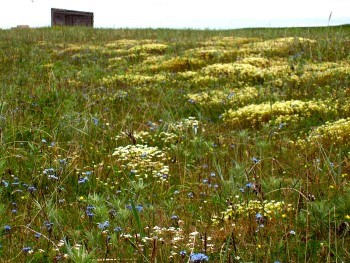
NPS Photo/Thea Garrett Cape Krusenstern National Monument is most famous for its archeological sites. They depict every known cultural period in arctic Alaska and provide information about both prehistoric and historic Native cultures. Like the rest of northwest Alaska, however, Cape Krusenstern is also rich in natural resources. If you look at a map, you will see the Krusenstern coast and a series of lagoons just inside it. The coast is created by the Chukchi Sea and Kotzebue Sound. The brackish lagoons open and close seasonally according to the movements of barrier spits and islands. The shore lands and waters provide excellent animal habitat: marine mammals, terrestrial mammals, birds and fish abound. Like most of the mid to high arctic, the soils in the monument are underlain by a continuous swath of permafrost—soil frozen solid for up to hundreds of feet beneath the surface. The depth of the seasonally thawed soil—or “active layer”—varies from tens of feet beneath streams or water bodies to a foot or less in the uplands. As snowmelt and rain are blocked from percolating by shallow permafrost, these soils are typically wet and usually covered with cotton grass tussock tundra. Soils on the lower slopes are typically poorly drained, and covered with peat, or partly decomposed plant remains. Cape Krusenstern’s highest point (Mt. Noak, 2010 feet) frequently have moderately shallow depths to bedrock and are not permanently frozen. These soils tend to be better drained. 
NPS Photo/Kean Mihata Most of the monument’s rolling topography is covered by moist to wet tundra. Wet cotton grass tussock tundra covers a sizeable portion of the monument and can be found in most areas with a thin active layer and low to moderate slopes. Dwarf birch, blueberry, cranberry, salmonberry, dwarf willows and Labrador Tea colonize the slightly drier microhabitats. Peat mosses (or Sphagna) grow in thick mats on the wettest sites, further acidifying this already acidic and nutrient-poor growing environment. On the drier terrains of the alpine areas, drier tundra types prevail hosting Dryads, heathers, and an exuberance of wildflowers. Prolific nonvascular plants make up 75% of the plant diversity and include lichens, mosses and liverworts Riparian environments are rich with tall willows, alder, horsetails and thick moss mats. There are only a few tiny pockets of boreal spruce forest, though these pockets are likely to spread with climate change . In the windswept high elevations, the plant mat is only a few inches high, dominated by tiny prostrate shrubs and lichens. Clear, fresh streams drain the monument. Pike, Dolly Varden, and grayling are common fish. Air quality is generally excellent, though arctic haze derived from distant pollution sources occasionally is not uncommon during the winter. Varieties of ducks, geese, loons, and other birds fly overhead. Caribou are the most common large mammal. The ones in the monument are part of the Western Artic Caribou herd. The herd, nearly 500,000 animals, ranges over the entire northwest Alaska region. The caribou are one part of a complex structure of land mammals ranging from small ground mammals to brown bears. In between are hare, moose, muskoxen, fox, wolves, and more than a dozen other animals. The National Park Service is committed to the protection of the plant and animal populations in the monument. Alone or in coordination with other federal and state agencies, the NPS routinely conducts biological research in the monument. Some of the current research is focusing on coastal erosion, the effects of contaminants along the Red Dog mine road corridor, and muskoxen and moose populations. |
Last updated: March 28, 2025
